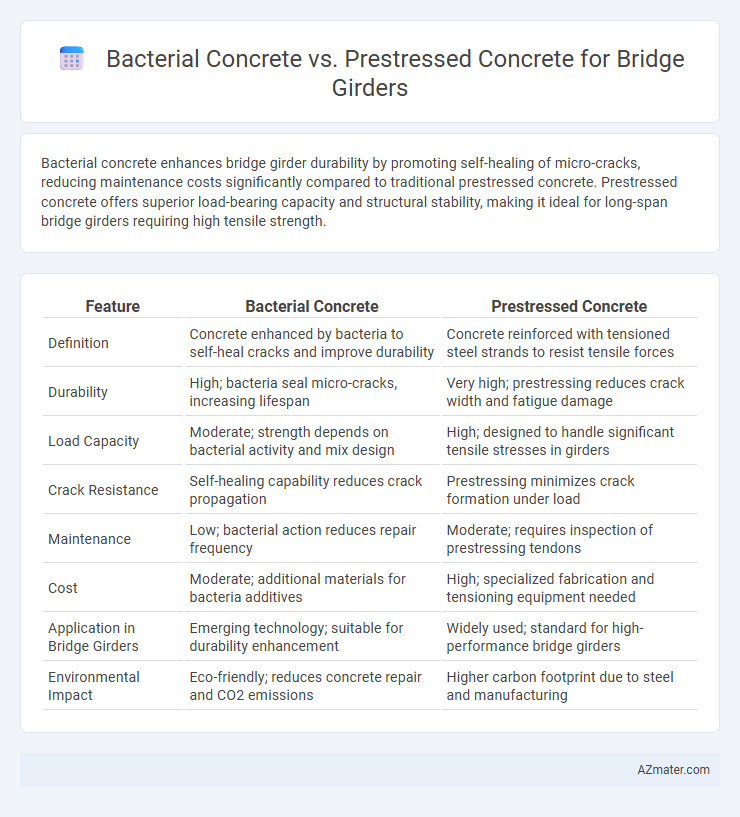Bacterial concrete enhances bridge girder durability by promoting self-healing of micro-cracks, reducing maintenance costs significantly compared to traditional prestressed concrete. Prestressed concrete offers superior load-bearing capacity and structural stability, making it ideal for long-span bridge girders requiring high tensile strength.
Table of Comparison
| Feature | Bacterial Concrete | Prestressed Concrete |
|---|---|---|
| Definition | Concrete enhanced by bacteria to self-heal cracks and improve durability | Concrete reinforced with tensioned steel strands to resist tensile forces |
| Durability | High; bacteria seal micro-cracks, increasing lifespan | Very high; prestressing reduces crack width and fatigue damage |
| Load Capacity | Moderate; strength depends on bacterial activity and mix design | High; designed to handle significant tensile stresses in girders |
| Crack Resistance | Self-healing capability reduces crack propagation | Prestressing minimizes crack formation under load |
| Maintenance | Low; bacterial action reduces repair frequency | Moderate; requires inspection of prestressing tendons |
| Cost | Moderate; additional materials for bacteria additives | High; specialized fabrication and tensioning equipment needed |
| Application in Bridge Girders | Emerging technology; suitable for durability enhancement | Widely used; standard for high-performance bridge girders |
| Environmental Impact | Eco-friendly; reduces concrete repair and CO2 emissions | Higher carbon footprint due to steel and manufacturing |
Introduction to Bridge Girder Concrete Technologies
Bacterial concrete and prestressed concrete represent innovative technologies in bridge girder construction, each enhancing structural performance through distinct mechanisms. Bacterial concrete utilizes microbial induced calcite precipitation to self-heal cracks and improve durability, whereas prestressed concrete incorporates high-tensile steel tendons tensioned prior to loading to resist tensile stresses effectively. These advancements address critical demands for longevity and load-bearing capacity in modern bridge design, optimizing the lifespan and safety of bridge girders.
Understanding Bacterial Concrete: Composition and Mechanism
Bacterial concrete incorporates specific bacteria, typically Bacillus species, embedded within the concrete matrix that precipitate calcium carbonate, enhancing self-healing and durability properties. This biologically active composition improves micro-crack repair and reduces permeability compared to conventional prestressed concrete, which relies solely on mechanical reinforcement to bear tensile stresses in bridge girders. Understanding the mechanism of bacterial concrete emphasizes microbial-induced calcite precipitation as a sustainable approach to extend the lifespan and performance of bridge structures.
Prestressed Concrete: Principles and Process
Prestressed concrete for bridge girders involves the application of high-tensile steel tendons stressed before or after concrete casting to counteract tensile stresses, enhancing structural capacity and durability. The principle relies on inducing a pre-compression in the concrete, allowing it to resist service loads effectively, minimize cracking, and optimize material usage. This process includes tensioning steel tendons either pre-tensioning or post-tensioning methods, anchoring them to the concrete, and carefully controlling stress levels to achieve optimal performance in bridge girders.
Strength and Durability Comparison
Bacterial concrete enhances strength and durability in bridge girders by promoting self-healing of microcracks through bacterial calcite precipitation, significantly reducing permeability and extending service life. Prestressed concrete offers high initial strength and improved load-bearing capacity due to pre-tensioned or post-tensioned reinforcement, minimizing tensile stresses and enhancing crack resistance under heavy loads. While prestressed concrete provides superior structural performance in high-stress scenarios, bacterial concrete contributes to long-term durability by autonomously repairing damage, reducing maintenance needs and increasing lifespan.
Crack Resistance and Self-Healing Capabilities
Bacterial concrete exhibits superior crack resistance and self-healing capabilities compared to prestressed concrete due to the incorporation of calcite-producing bacteria that seal microcracks naturally, enhancing durability. Prestressed concrete relies on mechanical pre-tensioning to control cracking but lacks intrinsic self-healing properties, often requiring maintenance for crack repair. The bio-mediated calcite precipitation in bacterial concrete reduces permeability and extends service life, making it an innovative solution for bridge girders exposed to dynamic loads and environmental stressors.
Maintenance and Lifecycle Costs
Bacterial concrete significantly reduces maintenance costs for bridge girders due to its self-healing properties that repair micro-cracks and prevent water ingress, extending the structure's lifespan. Prestressed concrete, while offering high strength and durability, typically incurs higher lifecycle costs from routine inspections, crack repairs, and corrosion protection of steel tendons. Over the bridge's service life, bacterial concrete can provide cost savings by minimizing maintenance frequency and delaying major repairs, enhancing overall lifecycle efficiency.
Environmental Impact and Sustainability
Bacterial concrete enhances sustainability in bridge girder construction by utilizing microbial-induced calcium carbonate precipitation to self-heal cracks, significantly reducing maintenance needs and extending service life. Prestressed concrete, while offering superior strength and load-carrying capacity, involves higher carbon emissions due to extensive use of steel tendons and energy-intensive production processes. Incorporating bacterial concrete reduces the overall environmental footprint through lowered cement consumption and improved durability, making it a more eco-friendly option for sustainable infrastructure projects.
Performance in Harsh Bridge Conditions
Bacterial concrete enhances durability in harsh bridge conditions by self-healing microcracks and resisting chemical attacks, significantly reducing maintenance costs. Prestressed concrete offers superior load-bearing capacity and crack control under heavy traffic and dynamic loads, ensuring structural integrity over long spans. Combining bacterial concrete with prestressing techniques can optimize performance by merging self-repair capabilities with high tensile strength for extended lifecycle bridges.
Case Studies: Real-world Applications
Bacterial concrete has demonstrated enhanced durability and self-healing properties in bridge girder applications, as seen in the case study of the Indian National Highway bridge where bio-concrete reduced crack propagation by 40%. Prestressed concrete remains widely utilized in major infrastructures like the Millau Viaduct in France, showcasing superior load-bearing capacity and long-span performance. Comparative analyses reveal bacterial concrete excels in maintenance cost reduction, while prestressed concrete offers proven reliability for high-stress, large-scale bridge girders.
Future Trends in Bridge Girder Construction
Bacterial concrete incorporates microbial-induced calcium carbonate precipitation to enhance self-healing properties, reducing maintenance costs and extending the lifespan of bridge girders. Prestressed concrete offers superior load-bearing capacity and crack control, facilitating longer spans and slender designs critical for modern bridge construction. Future trends emphasize integrating bio-based self-healing technologies within prestressed concrete to optimize durability, sustainability, and structural performance in bridge girder applications.

Infographic: Bacterial concrete vs Prestressed concrete for Bridge girder
 azmater.com
azmater.com